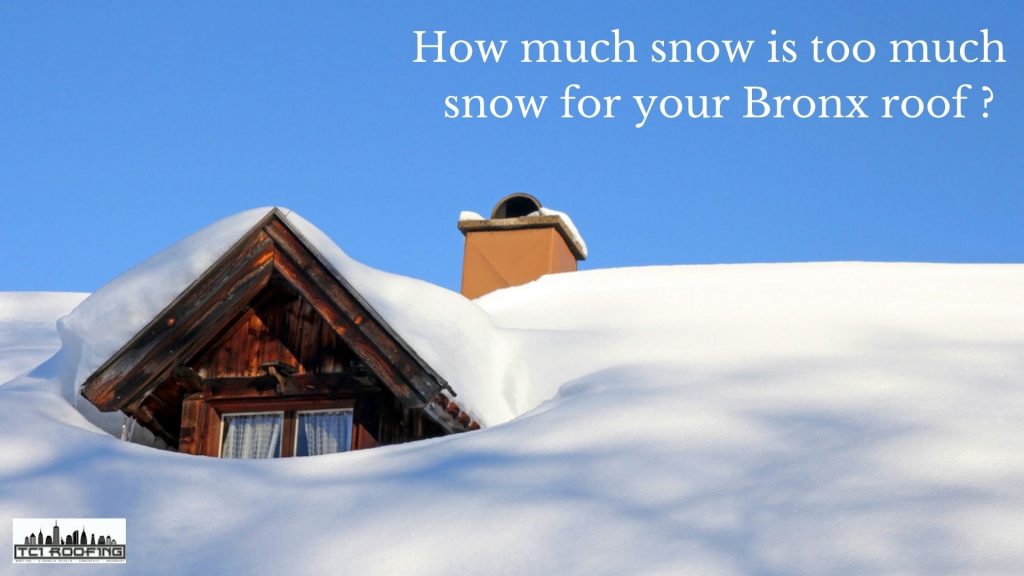In Bronx, the winter season is one of the most beautiful seasons of the year. The season’s radiance provides a winter wonderland-like environment with flat terrain and frosty tree lines interlaced through the area’s most historic neighborhoods.
On the other hand, extreme winter weather can bring an excessive amount of winter snow, which can cause havoc with your home. On the surface, your neighborhood may appear charming and serene, but heavy snow on your roof may be causing leaks and ice jams that are undetectable. Your roof may even be at risk of collapsing in the worst-case situation. So it’s past time to prepare for tragedy. Even though it is late in the season, the weather in Bronx is fickle. Roofing repair in Bronx has a long waiting list, so use these tips to maintain your roof in good shape through spring and winter storms.
Figure How Much Weight your Roof Can Support
Determine the maximum weight that your roof can support. For example, most roofs can withstand snowfall of 20 pounds per square foot.
Calculate the Weight of the Snow on Your Roof
Determine how much snow has piled on your roof and how much it weighs. Your roof can probably handle four feet of snow since ten inches of fresh snow weighs around five pounds per square foot. On the other hand, Packed snow is much heavier: two feet or more of old snow can easily exceed weight limits. The weight of old and new snow combined can quickly exceed the load capacity of the vehicle. Just two feet of each can cause a roof to collapse. Also, remember to account for ice. A foot of fresh snow weighs the same as an inch of ice.
Remove Excess Snow and Ice
Any wet snow or ice that has accumulated should be removed. A clearing rate of more than 20 pounds per square foot is required. The ideal snow rake to use is one with a long extension arm. You might also hire a professional to remove all the snow and ice for you.
Look for Signs of a Stressed Roof
Keep an eye out for symptoms that your roof is suffering from wear and tear. Sagging ceiling tiles, sprinkler lines, popping or creaking noises, jammed doors and windows, cracked walls, or a leaky roof is all signs of a roof that has become overworked.
How Much Snow is Too Much Snow on a Roof?
Most Manhattan roofing contractors can give you a fair rule of thumb regarding the amount of snow your roof can handle. Snow accumulation is recorded in weight rather than inches. Light, fluffy snow weighs less than heavy, dense snow, while packed snow weighs more than freshly fallen snow. Most home roofs are capable of supporting snow loads up to 20 pounds per square foot. Keep a check on the snow accumulation on your roof whenever it snows, as a Manhattan roof replacement is expensive.
Can Snow Be Too Heavy For Roof?
According to the Insurance Institute for Business and Home Safety, most home roofs in good condition can hold 20 pounds of snow per square foot. When the weight of the snow on your roof reaches this limit, use the following rules to determine:
- Freshly fallen snow: Snow that has recently fallen weighs around 20 pounds per square foot (about four feet).
- Old, Packed Snow: A two-foot layer of old, packed snow weighs around 20 pounds per square foot.
- Mixed new and old snow: Two to three feet of new and old snow equals 20 pounds per new and old snow square foot.
How Much Snow Should You Take off Your Roof?
It’s a good idea to clear your roof after every 6 inches of snowfall. Ice dams are significantly less likely to form if you don’t allow too much snow to accumulate on your roof, and you won’t have to worry about a roof cave-in.
It is necessary to manually clear snow from your roof when it accumulates faster than it melts. If you wish to clear the snow manually, take the following steps to safeguard yourself and your roof:
- It is never a good idea to attempt to clear snow on your own.
- Remove the snow with a telescopic roof rake while standing on the ground to avoid bodily injury.
- Clear snow and icicles from the roof’s edges first. This is sometimes all that’s needed for the remainder of the snow to slide away.
- If you need to use a ladder, be sure it’s noticed over and in good operating order. Place it firmly in a snowdrift before climbing up.
- Always use a safety harness when on your roof. Make sure the harness is securely connected to a solid anchor point to avoid dangerous falls.
- When clearing snow from your roof, use plastic shovels instead of metal tools, as metal tools can harm your roofing material and cause structural issues.
Is it Bad To Have Snow on Your Manhattan Roof?
Snow accumulation on your roof can lead to serious water damage, costing an average of $2,386 in roof repair costs. Flat roofs are particularly vulnerable because snow cannot roll off, causing the pile to grow and become heavier.
If you have concerns about the snow on your roof or are experiencing storm damage due to the recent snowfall, contact your local roofing services in Bronx for assistance.
Thoughts
Roof snow removal should be done regularly to avoid roof collapse and leaks. Winter snowstorms, however, have a way of dumping far more snow than your roof can handle at once. Call TCI Roofing Repair Contractor Company Bronx NY, for timely and effective residential winter damage restoration services if you wake up to an unexpected snowfall and a leaking roof. Our team will create a comprehensive restoration strategy and work promptly to restore your home to its pre-loss condition, allowing you to resume enjoying the holidays.

